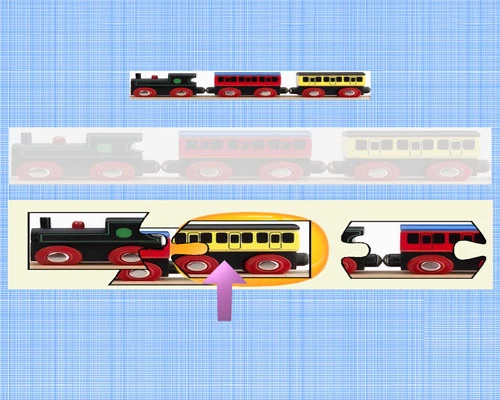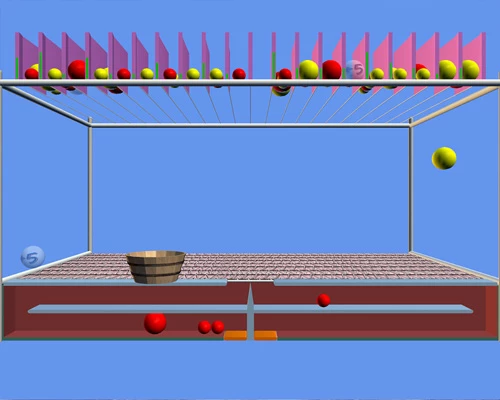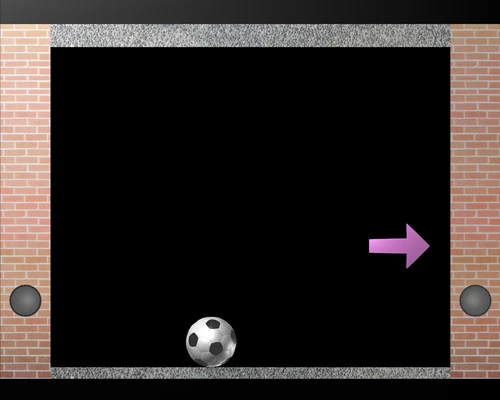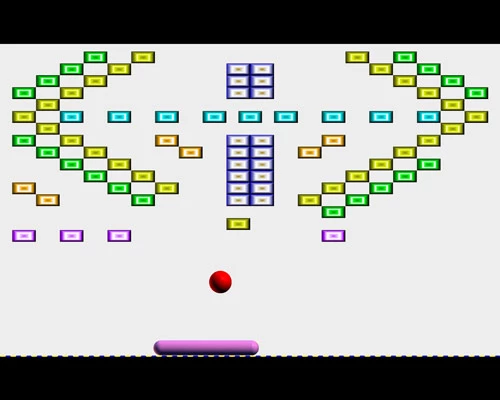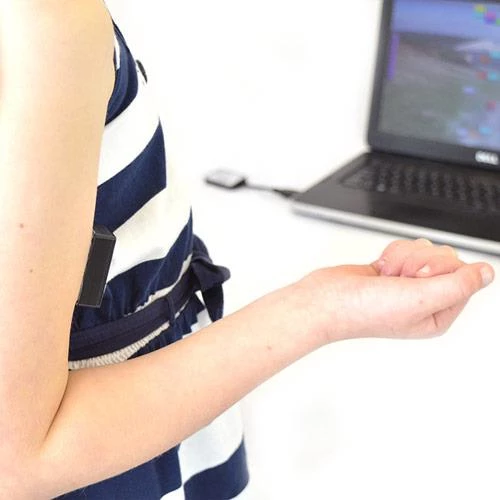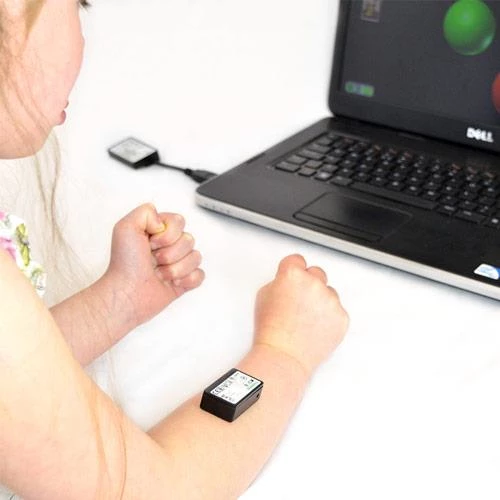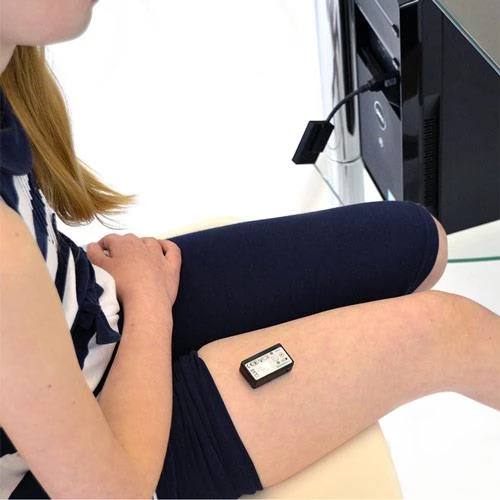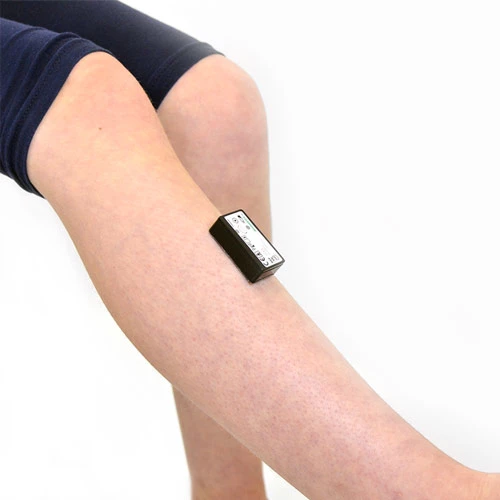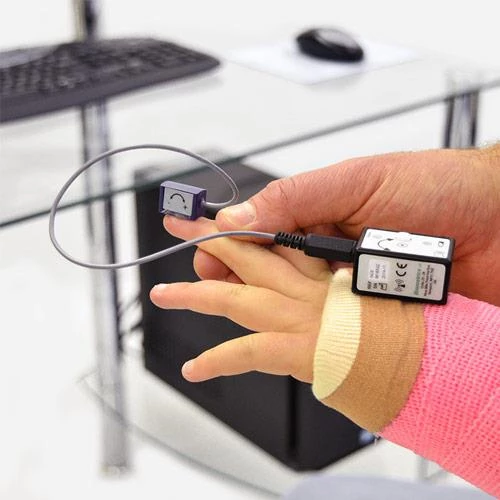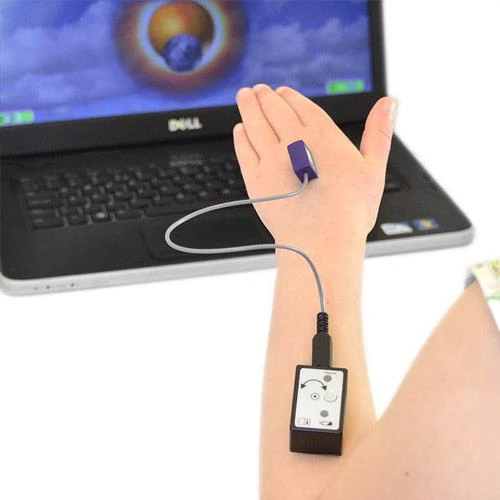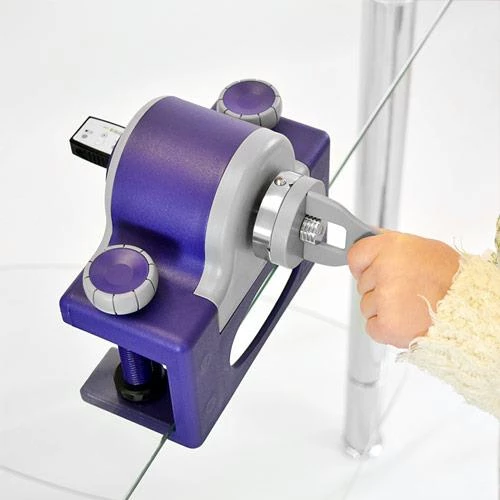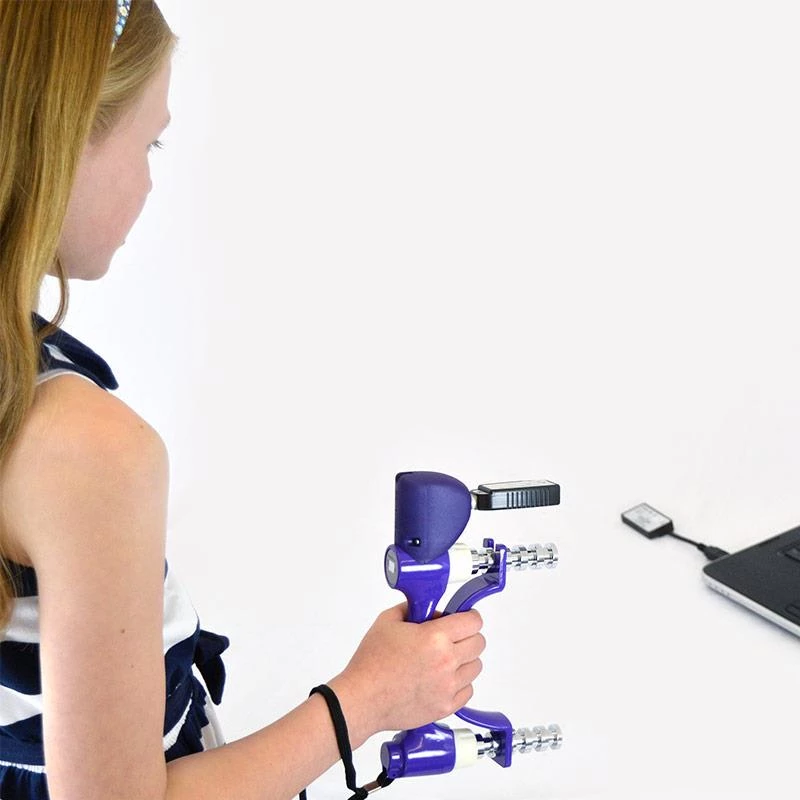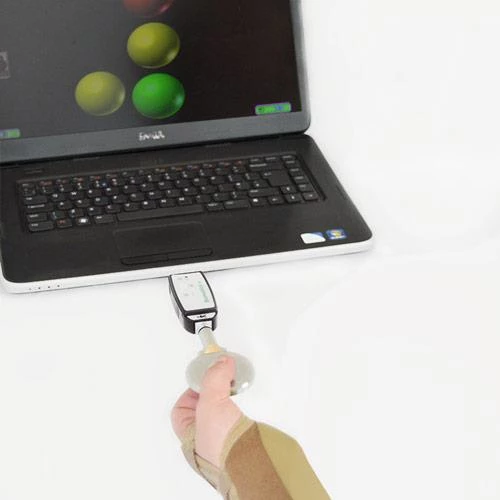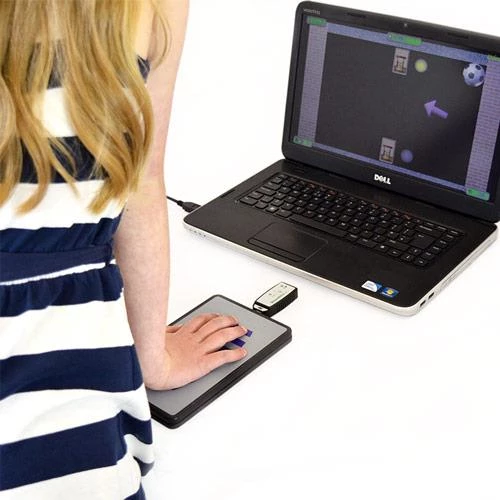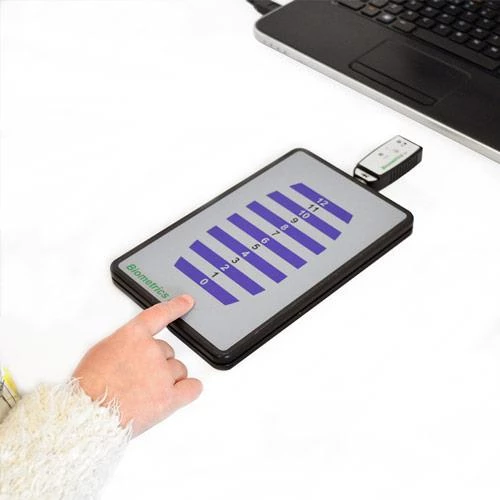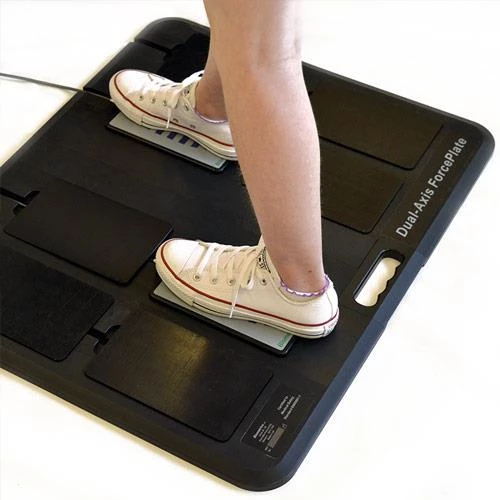Innovative Exercise
Various E-LINK devices and Activities provide innovative, gradable, functional exercise for children and young people throughout the full rehabilitation process, encouraging muscle strengthening and restoration of normal movement patterns.
Activities
The Activities incorporate a fun element into each therapy session, maximizing the child's motivation for exercise.
- Baseline measurements are quickly and accurately taken with various E-LINK devices and automatically entered as the range for the chosen Activity which can be further graded to suit the child's needs or therapy goals
- Various Activities with eye-catching graphics are designed as the visual stimulus for the child to engage in gross end range movement through to finer controlled movement
- Biofeedback is displayed in real-time to the child through the movement of objects on the screen
- A % score and an Activity distribution graph are generated at the end of play for further objective analysis, for discussion with older children as a motivation opportunity and for re-assessment of therapy goals
- Following the Exercise session E-LINK Software generates documentation in both graphs and tables which can be entered into the child's record
E-LINK Myo-EX
For children who have physical limitations due to congenital conditions such as cerebral palsy or who for instance have injuries and are post - surgery, exercise can begin where there is very little or even no visible joint movement.
The Myo-EX sensor excitingly detects very small flickers of muscular activity and using surface EMG, provides immediate biofeedback to the child through the visual movement of objects in the Activity. In order to achieve a good score the child is encouraged for instance to match colors or hit a football against a wall. In turn the child is then focusing on a smooth, efficient and co-ordinated movement to achieve the Activity rather than recruiting unnecessary compensatory movements.
- Myo-EX is ideal for wrist and elbow exercise, focused exercise on the shoulder musculature, knee and ankle exercise and has even been used with certain facial muscles
- Biofeedback is immediate providing a high degree of motivation for exercise
- The precision sensor is designed to give superb quality of signal and can detect as little as 3-4 microvolts of electrical activity
- Full scale reaches up to 3000 microvolts for working with larger muscles - deltoid, bicep or quads
- The Myo-EX sensor is quick and easy to apply, with little to no skin preparation, ideal for busy Units
E-LINK AngleX
Where some joint movement is observed but it is insufficient as yet to grasp or hold other devices, AngleX sensors are ideal to use with children of all ages. They are simply attached close to the joint for exercise and respond to active movement against gravity. AngleX provides focused exercise for even small DIP joints through to larger body joints.
- AngleX encourages normal patterns of movement and discourages compensatory ones
- Fuss free application, ideal for busy Units
- No skin preparation needed, simply apply to clean, dry skin using the medical grade tape, close to the joint to be exercised
- Baseline readings are taken in 1 degree increments for the child's comfortable ROM. These are automatically entered as the range for the chosen Activity which can be graded to suit the therapy goals of each individual child
- The small AngleX is used for the fingers, thumb and wrist
- The large AngleX is used for the forearm, elbow, shoulder, hip, knee and ankle joints
E-LINK Upper Limb Exerciser
If the child has a degree of grasp to hold items, the Upper Limb Exerciser with various tool handles is ideal for functional, repetitive active exercise. Resistance to the active movement can also be graded for muscle strengthening goals.
- Ideal for active and active resistive exercise of the fingers, wrist, forearm, elbow, and shoulder
- Baseline measurements of the child's comfortable ROM are taken and automatically entered in the Activities chosen for exercise
- The range can be set to as little as 2 degrees ROM enabling exercise for children with very little movement (for example, those recently out of a plaster cast) and gradually graded over time to a full range of motion
- The resistance can be adjusted and graded according to need throughout the rehabilitation process for muscle strengthening exercise
- Simple to set up and quick to use - ideal for busy Units
E-LINK Dynamometer
The E-LINK Dynamometer is an accurate, sensitive device, registering as little as 0.1kg/lb strength measurements, thus enabling evaluation to commence very early in the child's recovery and continue throughout the full rehabilitation process, monitoring the child's progress.
Immediately following precise evaluation, the Dynamometer is ideally placed to be used for unique isometric grip exercise combined with the innovative E-LINK Activities.
- The movement of the objects in the Activity is controlled by the application and relaxation of isometric grip within the set parameters
- Activities such as Load Ship (moving containers from the quayside to the hold on a ship) encourage the child to exercise from full relaxed grip to their maximum application of force, including the option to sustain the grip for a determined period of time
- Other Activities such as Break It (moving a block to hit objects in a picture scene) encourage the child to work to random points in the range thus addressing a functional application of variable grip strength
- The various Activities provide purposeful movement, isometric strengthening, motor learning and control as well as motivational entertainment for the child undergoing treatment
E-LINK Pinchmeter
To assess the finer motor control in pinch grip, the E-LINK Pinchmeter easily and accurately measures a child's pinch strength from 0.1kg/lb measurement through to a maximum of 22kg (50lbs).
As with the E-LINK Dynamometer, the Pinchmeter is used for unique isometric Pinch Exercise and is ideal to use immediately following Evaluation.
- The Pinchmeter can be positioned in such a way as to address functional ADL goals e.g. key in the door, holding a pen, pressing a doorbell
- The Pinchmeter is also perfect for fingertip desensitization exercise in pain management programmes
E-LINK ForcePlates
One, two or four ForcePlates can be connected to the X4 InterX Unit which is the USB interface to the Computer. A single ForcePlate may be used with the E-LINK Dongle for a wireless interface to the Computer.
The superb, versatile modularity of E-LINK enables the ForcePlates to be used in many clinical situations for children and young adults - for full standing balance on 4 ForcePlates through to the light touch of one finger on a single ForcePlate for desensitization exercise – ideal for the many diverse clinical situations facing clinicians in Paediatric Units.
- For balance training baseline measurements are taken of the child's comfortable limits of stability and these are used in the Activities for single or dual axis movement. The parameters may be further graded to suit the child's physical and cognitive state, ensuring the goals are achievable for each individual child
- To accomplish the goal of an Activity the child needs to sway, loading and unloading the weight distributed over the ForcePlates
- Lower extremities are strengthened whilst also encouraging proprioception, motor control and balance
- For additional flexibility the ForcePlates can be removed from the BaseFrame and used with other everyday equipment to achieve functional goals – for example, with a gym ball, a wheel chair or a wobble balance board
- The Activities can be saved in a set sequence and used again for the next session thus saving set-up time for the clinician as well as familiarising the child to the Activities
Mini Case History #1 - Using the Dual Axis ForcePlates
Pediatrics - Mini Case History #1
From a Paediatric Unit in England - Therapist
“A young man recently attended our unit for a rehab block. He had developed a post viral functional weakness 7 months previously which resulted in difficulties in controlling his legs, and antigravity active ranges at the hips and knees. He had an extremely slow gait pattern and was unable to manage walking for distances of over 100m. He was unable to ascend or descend stairs apart from on his bottom. He was attending school just one day per week and isolated to his bedroom for home study for the rest of the week. He had previously been very active and was one of the fastest runners in his class, but had had to give up playing football which had been very important to him. We used the dual axis forceplate on a daily basis, starting with simple weight shifting from left to right and gradually increasing the demands. We saw his strength, speed, and body awareness improve over the course of the session and again when he presented again the next day. Towards the end of the block we were able to set the system up to replicate climbing stairs and speeding up his weight shifting as per a normal walking speed. He left the hospital walking at a normal pace, could climb and descend stairs on his feet, and manage longer distance walks of up to 1km. He's looking at returning to school full time after the summer holidays and we expect he'll soon regain his higher level gross motor skills and be able to recommence his sports and other active leisure pursuits.”
From the Patient
“I was admitted into hospital for two weeks with weakness in both legs. During my two weeks in hospital, Biometrics E- LINK helped me get back to walking in just two weeks. In my first session of O.T I used Biometrics E-LINK and kept using it until my last sessions of O.T. It was a lot of hard work but it also made getting better fun and a lot easier to do. Some of the reasons why it is so good is that there are so many different things on there and all of it helps also, for young children, they would love the games they do on it. It's just great. I am really glad I got to try the Biometrics and I'm thankful because it helped me get back to walking.”

- One single ForcePlate may be used for weight bearing exercise, from the touch of one finger through to full weight bearing on one limb
- Each ForcePlate registers weight as little as 0.1kg/lb through to 100kg (220lbs)
- Ideal for light touch/short duration exercise in pain management programmes through to full weight loading for strengthening joints and encouraging specific movement patterns
Mini Case History #2 - Using a Single ForcePlate
Pediatrics - Mini Case History #2
From an OT Dept in Hull - Therapist
“…We used it... with one patient, a young boy who actually had a foot problem, hadn't worn a sock or shoe for months, reluctant to weight bear on affected foot so we adapted the use of the force plate to show that he was able to weight bear and he enjoyed the games, within a short time he was wearing socks and shoes and reached his goal to return to school without crutches and be able to join in properly with his friends and not be secluded for his studies as he was unable to get to his classes!”


